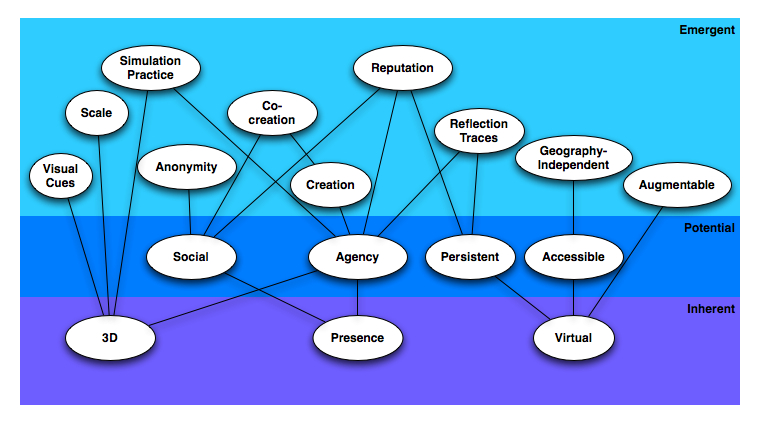I recently attended the 3DTLC conference, as I reported before. Chuck Hamilton presented on his (IBM’s) take on affordances on virtual worlds. Given that I’ve opined before, I asked for more detail on their take, and he was kind enough to forward to me their definitions. I like what they’ve done, but it led me to try to refine what I see as some confounding (they actually separate several of their 10 into two separate ones), and try to capture what I think are core, what can be enabled, and what then arise from those capabilities.
 I start with what I think are the core affordances of virtual worlds, that there’s a 3D world, that you can visit, and that’s digital. From there, I see that you can enable others to be there (social), you can enable action (agency), the world can be kept around (persistent), and it can be made accessible broadly (e.g. through the internet).
I start with what I think are the core affordances of virtual worlds, that there’s a 3D world, that you can visit, and that’s digital. From there, I see that you can enable others to be there (social), you can enable action (agency), the world can be kept around (persistent), and it can be made accessible broadly (e.g. through the internet).
If you choose to enable those (and you should, in most cases), you get some emergent properties. Chuck talked about a universal visual language, and you certainly can both tap into, and establish, visual cues. The scale does not have to be real, but can indeed scale down to and up to any size you want, in part or all.
You can choose to be anonymous, but if you don’t and choose to have a representation that is active over time, you can establish a reputation.
By being active, you can also enable practice opportunities such as simulations, scenarios, and games. If agency includes not just interaction, but creation, and you have social, you can have co-creation (one of the most exciting opportunities for informal learning). The persistence of your activity creates the opportunity to capture traces for reflection, e.g. ‘after-action review’.
The fact that it’s digital means it can be augmented with external capability: media, applications, and more. Also, you can be at least geography-independent, if not chronologically-independent.
This is a preliminary stab at trying to trace the initial, potential, and consequently emergent affordances, by no means do I think it’s the definitive answer. Feedback solicited!
Well, Clark, I don’t see a lot of daylight between us here. I’m very much aligned with you on this topic.
Collective intelligence, enabled by having unfettered access to a small number of (not even complimentary) mechanisms for activity, and new behaviors form for the group. How complex or what kind of collective behavior results from that has much to do (IMHO) with the activity channels. Even when you design a social system and engineer it with certain end goals, there may be a lot of things people can do within the parameters you’ve set up that you haven’t counted on
That’s what we’re all doing when we’re intentionally building social structures. As emergent behaviors make themselves evident, you can tweak the activity channels and allow for different results, but it still requires the emergence of group behavior to make it clear what you’ve turned on.
What I find interesting is when a system is designed to allow the group in some way to alter the underpinnings of its own activities. There are concrete examples where there’s a collective consciousness that changes the system’s rules so that it affords different emergent behaviors, instead of a top-down arbitrage. Generally, we tend to look at those examples as revolutions.
Thanks for giving me something to stew on this morning, Clark!
Another affordance, perhaps linked to Reputation and Anonymity, is Persona. You can create an online presence that is markedly different from your real-world self. Social-science researchers are using this to explore body image, gender roles, racial identity, and so forth. Some data I’ve seen shows that a large percentage of Second Life residents have opposite-gender avatars. There are the fantasy avatars (vampire, babe, etc.) And then of course there are the non-human avatars, “furry” fetishists, etc.
Something else to consider is the communication affordances of VWs, both asynchronous and synchronous. I’ve noted a tendency to use text chat even when everyone in the group has voice capability. Mixed-more synchronous communication is an interesting phenomenon as well.
These aren’t unique to VWs, of course. People create personas in the real world all the time. Twitter or chat backchannels during conference presentations are becoming common. But looking at them in the context of VWs, together with the unique affordances of VWs, may be enlightening.
Regards,
Corrie
Thanks, Aaron & Corrie. I see you both picking up on the possibilities that new affordances can emerge. Definitely we’re still seeing emergent phenomena, and the question is are they fundamental, or combinations of existing affordances. Still to be determined, but thought I’d take a stab.
Interesting idea, Aaron, allowing individuals to change the rules of the environment (Jeff Johannigman introduced me to the game Fluxx, a great lesson in that). That’d be interesting, to have a layer of rules on top of the kernel that define the policies and processes, and allowing that to emerge (maybe to a demonstrably responsible subgroup). I believe that’s what was happening in some of the MOOs.
Corrie, I thought that persona was the opposite of anonymity, and included the ability to represent yourself how you want visually as well as behaviorally. I think you’re right, however, that it’s emergent on top of social and persistent, and may be a parallel to reputation.
The alternate communication channels you both directly or indirectly mention I think of as augmentation, but you caution me to not take that as a given, but continue to track. THANKS!